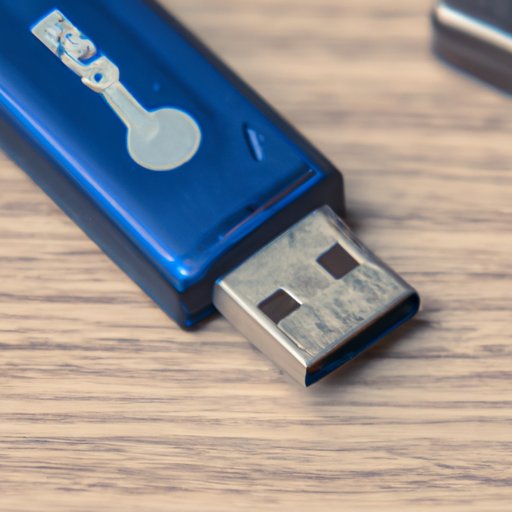Introduction
Universal Serial Bus (USB) is a computer technology that enables data transmission between electronic devices. It is used to connect peripherals such as keyboards, mice, printers, external hard drives, and other peripherals to computers and laptops. USB has become an essential part of computing and is now used in almost every device. This article will explore the benefits of USB technology in business and home computing, how it works, a comprehensive history of USB, and troubleshooting common USB issues.
What is USB?
USB is a standard port that allows different types of electronic devices to be connected to a computer or laptop. USB ports come in different sizes and shapes, but all have the same purpose: to allow the transfer of data between two devices. The most common type of USB port is the Type-A connector, which is found on most desktop and laptop computers. Other types of USB connectors include Type-B, mini-USB, micro-USB, and USB 3.0.

Benefits of USB in Business and Home Computing
The introduction of USB technology has revolutionized the way businesses and consumers use computers. USB makes it easier to connect multiple devices to a single computer or laptop, eliminating the need for separate ports for each device. This means users can quickly and easily transfer data between devices, reducing time and effort. USB also offers faster data transfer speeds than traditional ports, making it ideal for large file transfers. Finally, USB is widely compatible with a variety of devices, meaning users don’t have to worry about compatibility issues.
How USB Technology Works
USB technology works by sending data over a four-wire cable. The four wires are power, ground, data+, and data-. Power and ground provide the power needed to run the device, while the data+ and data- lines send and receive data. When a device is plugged into the USB port, the operating system recognizes the device and configures it accordingly. Once configured, the device is ready to send and receive data.
Overview of USB Specifications
USB has several different specifications that define the speed and power output of the port. The most common specifications are USB 1.1, USB 2.0, USB 3.0, and USB 3.1. Each version offers increased speed and power output compared to the previous version. For example, USB 3.1 offers up to 10GB/s of data transfer speed and 100W of power output, while USB 2.0 offers up to 480MB/s of data transfer speed and 2.5W of power output.
Exploring the Different Types of USB and Their Uses
In addition to the different specifications, there are also different types of USB connectors. The most common type of USB connector is the Type-A connector, which is found on most desktop and laptop computers. Other types of USB connectors include Type-B, mini-USB, micro-USB, and USB 3.0. Each type of connector has different uses, from connecting peripherals to charging mobile devices.

A Comprehensive History of USB
USB technology was first introduced in 1996 by a group of companies, including Intel, Microsoft, Compaq, and IBM. The original version of USB, USB 1.1, offered data transfer speeds of up to 12Mbps. Since then, USB standards have evolved to offer faster data transfer speeds, more power output, and improved compatibility. The latest version of USB, USB 3.1, offers data transfer speeds of up to 10Gbps and power output of up to 100W.
Troubleshooting Common USB Issues
One of the most common issues with USB is compatibility. Some devices may not be compatible with certain versions of USB, or may require additional drivers to work properly. To fix this issue, users should check the device’s compatibility with their computer or laptop’s USB ports. Additionally, some USB devices may not work properly due to incorrect drivers or outdated firmware. To fix this, users should update their device’s drivers and firmware.
Conclusion
USB technology has revolutionized the way we use computers and other electronic devices. It is an essential part of computing, and is used to connect peripherals to computers and laptops. This article explored the benefits of USB technology in business and home computing, how it works, a comprehensive history of USB, and troubleshooting common USB issues. USB is a versatile technology that offers fast data transfer speeds and wide compatibility, making it an invaluable tool in both business and home computing.
Takeaways from this Article
USB technology is an essential part of computing, offering fast data transfer speeds and wide compatibility. It is used to connect peripherals to computers and laptops, and is commonly found on most devices. This article explored the benefits, specifications, history, and troubleshooting of USB technology, making it easier for users to understand and utilize this versatile technology.


